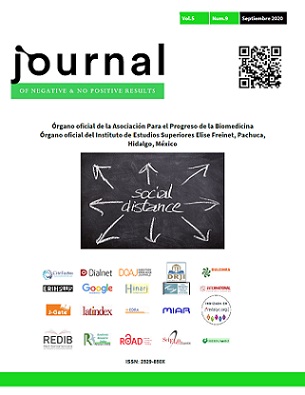Identification of potential drug interactions in geriatric patients
DOI:
https://doi.org/10.19230/jonnpr.3685Keywords:
Drug interactions, geriatric patient, polypharmacyAbstract
The patients of the third age make up the most medicated age group in society, mainly due to the increase in the prevalence of chronic diseases, therefore they are more likely to present drug interactions due to other factors dependent on the state of their organism, they present three main characteristics that differentiate it from other age groups: polypathology, polypharmacy and physiological changes related to aging that alter the pharmacokinetics and pharmacodynamics of medications.
Downloads
References
Gobierno federal. Guía de práctica clínica, Interacciones farmacológicas potenciales en el adulto mayor. CENECTEC.
Couso Seoane C. El pensamiento científico y el Envejecimiento. Actualización. Santiago de Cuba: Instituto Superior de Ciencias Médicas; 2006.
Cedeño Argilagos C. Función social de la epidemiología de los medicamentos. Su desarrollo en Cuba. Rev. Cubana Farma. 2008
Martínez Querol C, Pérez Martínez V, Carballo Pérez M, Larrondo Viera J. "Polifarmacia en Adultos Mayores". Rev. Cubana MGI. 2006; 21(1-2). Citado 22 febrero 2019. Disponible en http://bvs.sld.cu/revistas/mgi/vol21_1-2_05/mgi121- 205t.htm 7.
Vonbach P, Dubied A, Krähenbühl S, Beer JH. Prevalence of drug-drug interactions at hospital entry and during stay of patients in internal medicine. Eur J Intern Med. [Internet]. 2008 [Acesso 22 febrero 2019];19(6):413-20. doi: 10.1016/j.ejim.2007.12.002
Alomar MJ. Factors affecting the development of adverse drug reactions (Review article). Saudi Pharm www.eerp.usp.br/rlae Rodrigues MCS, Oliveira C. 15 J. [Internet]. 2014 [Acesso 22 febrero 2019];22(2):83-94. doi: 10.1016/j.jsps.2013.02.003
Carrasco García M, Hernández Mojena G. Longevidad Satisfactoria de la Población Cubana. Módulo 12 [CD- ROM]. La Habana: Editorial Ciencias Médicas; 2011.
Consejo Nacional de Población (CONAPO). (2011). Dinámica demográfica de México 2000-2010. En: La situación demográfica de México 2011. CONAPO. pp. 1-11 (Consultado: Diciembre 2012).
Guía práctica Clínica de “Interacciones Farmacológicas potenciales en la atención del adulto mayor” México Secretaria de Salud, 2010
Gómez- Dantes O, Sesna S, Becerril V, Knaul F, y cols. Sistema de Salud de México. Salud Pública Mex 2011: 53suppl Z: S220-S232
Delafuente JC. Understanding and preventing drug interactions in elderly patients. Critical Rev Oncol/Hematol 2003;48:133-43
Karas Jr S. The potential for drug interactions. Ann Emerg Med 1981;10:627–30.
Stanton LA, Peterson GM, Rumble RH, Cooper GM, Polack AE. Drug related admissions to an australian hospital. J Clin Pharm Ther 1994;19:341-7.
Classen DC, Pestotnick SL, Evans RS, Lloyd JF, Burke JP. Adverse drug events in hospitalized patients. JAMA 1997;277:301-6.
Doucet J, Chassagne P, Trivalle C, Landrin I, Pauty MD, Kadri N, et al. Drug-drug interactions related to hospital admissions in older adults: a prospective study of 1000 patients. J Am Geriatr Soc 1996;44:944-8.
Hohl CM, Dankoff J, Colacone A, Afilalo M. Polypharmacy, adverse drug-related events, and potential adverse drug interactions in elderly patients presenting to an emergency department. Ann Emerg Med 2001;38:66671.
.Bjorkman IG, Fasbom J, Schmidt I, Bernsten CB, Pharmaceutical Care of the Elderly in Europe Research (PEER) Group. Drug-drug interactions in the elderly.
Ann Pharmatother 2002;36:1675-81. Kurfees JF. Dotson RL. Drug interactions in the elderly. J Fam Pract 1987;25:477-88.
Björkman IK, Fastbom J, Schmidt IK, Bernsten CB, and the Pharmaceutical Care of the Elderly in Europe Research (PEER) Group. Drug–drug interactions in the elderly. Ann Pharmacother. 2002;36:1675-81.
Published
Issue
Section
License
All accepted originals remain the property of JONNPR. In the event of publication, the authors exclusively transfer their rights of reproduction, distribution, translation and public communication (by any sound, audiovisual or electronic medium or format) of their work. To do so, the authors shall sign a letter transferring these rights when sending the paper via the online manuscript management system.
The articles published in the journal are freely used under the terms of the Creative Commons BY NC SA license, therefore.
You are free to:
Share — copy and redistribute the material in any medium or format
Adapt — remix, transform, and build upon the material
The licensor cannot revoke these freedoms as long as you follow the license terms.
Under the following terms:
Attribution — You must give appropriate credit, provide a link to the license, and indicate if changes were made. You may do so in any reasonable manner, but not in any way that suggests the licensor endorses you or your use.
NonCommercial — You may not use the material for commercial purposes.
ShareAlike — If you remix, transform, or build upon the material, you must distribute your contributions under the same license as the original.
No additional restrictions — You may not apply legal terms or technological measures that legally restrict others from doing anything the license permits.

This work is licensed under a Creative Commons Attribution-NonCommercial-ShareAlike 4.0 International License

























